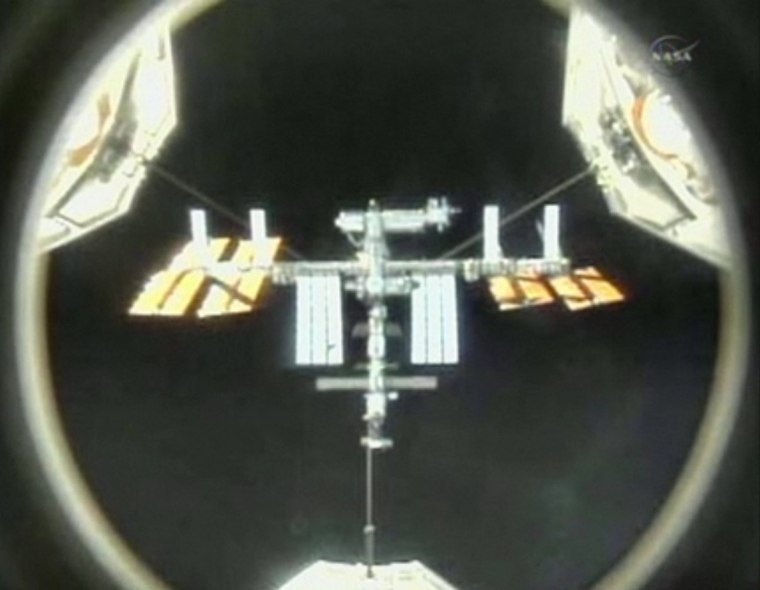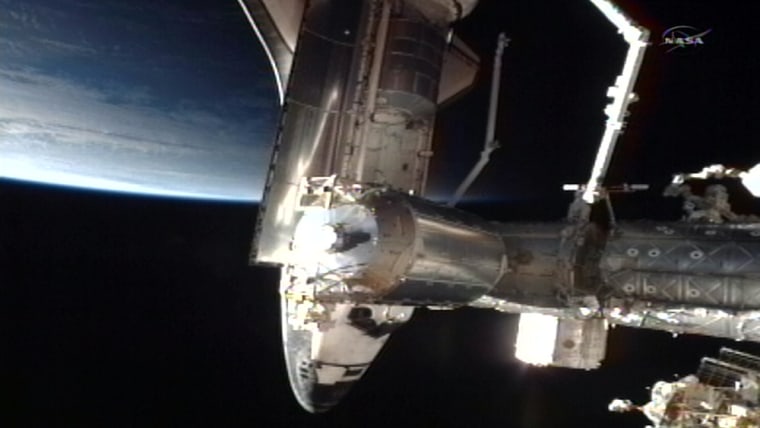Atlantis made the final docking of the 30-year space shuttle program on Sunday, hooking up with the International Space Station for a final resupply rendezvous.
Aboard the station, NASA astronaut Ron Garan rang a bell to mark the shuttle's arrival in traditional naval fashion.
"Atlantis arriving," he declared. "Welcome to the International Space Station for the last time."
"And it's great to be here," Atlantis commander Chris Ferguson replied.
During this 135th and final space shuttle mission, Atlantis is delivering more than four tons of food, clothes, spare parts, experiments and other space station supplies to keep the complex going in the post-shuttle era. NASA figures that this shipment will help keep the space station provisioned through the end of next year.
Computer glitch and potential space junk
The mission's lead flight director, Kwatsi Alibaruho, said Atlantis' crew encountered a "slight problem" well before the docking sequence when one of the shuttle's computers failed during the morning power-up. He explained that the computers' on-off switches "can be a little bit temperamental from time to time." If they're not flipped on decisively, that could create a glitch — which is apparently what happened on Sunday.
The shuttle uses three computers simultaneously to provide redundancy, and the glitchy computer was "voted out" and taken offline. Alibaruho expected that a Monday-morning reset would put the system right again. He also noted that the shuttle has two spare computers, just in case there's a hard failure.
Later in the day, mission management team leader LeRoy Cain said a piece of space junk might come close to the docked shuttle and station on Tuesday, the same day that the sole spacewalk of Atlantis' mission is scheduled to take place.
Cain didn't yet have details about the trajectory or precise nature of the debris, but he said that if the orbital path came too close, the shuttle could fire its thrusters to move the station out of the way.
'Powerful moment'
Alibaruho said Sunday was a "big game day" because of the last shuttle docking, and the gravity of the occasion sank in among members of the flight team at Johnson Space Center in Texas.
"It was a powerful moment for me. ... I was not feeling sadness, but that understandable and common and sober anticipation of what's coming next," Alibaruho told journalists.
This was the 46th docking by a space shuttle to a space station. Nine of those were to Russia's Mir station back in the mid-1990s. The U.S. and Russia built on that sometimes-precarious experience to create, along with a dozen other nations, the world's largest spacecraft ever: the permanently inhabited, finally completed, 12-year-old International Space Station.
Ferguson was at the controls as Atlantis closed in, leading the smallest astronaut crew since 1983.
Only four are flying aboard Atlantis, as NASA kept the crew to a minimum in case of an emergency. In the unlikely event that Atlantis was seriously damaged, the shuttle astronauts would need to move into the space station for months and rely on Russian Soyuz capsules to get back home. Since the 2003 Columbia tragedy, a shuttle had always been kept on standby for a possible rescue, but that's no longer feasible with Discovery and Endeavour officially retired now.

NASA said Atlantis seemed free of significant damage. But as a safeguard, the shuttle performed a final backflip for the space station cameras, an hour before the 230-mile-high (370-kilometer-high) linkup. The station astronauts captured high-resolution photos of the shuttle's protective tiles during the maneuver.
The orbital ballet move was executed without a hitch. "Poetry in motion," NASA mission commentator Rob Navias said. Over the next couple of days, experts on the ground will scrutinize the digital images for any signs of damage that might have come from fuel tank foam, ice or other launch debris.
Two hours after the docking, Atlantis' crew of four floated into the space station for a round of hugs and picture-taking with the space station's six-member crew. Because of the shuttle fleet's retirement, it could well be years before so many people are in space together again.
'Antlantis' crew has big moving job
After familiarizing themselves with the station, Atlantis' crew was due to transfer an inspection boom to the shuttle's robotic arm and then prepare for Monday's primary task: using the station's robotic arm to move the Raffaello logistics module out of the shuttle's payload bay and hook it up to the station for the cargo transfer.
Alibaruho said astronauts would have to hustle to move "bag upon bag upon bag" of supplies from Atlantis into the space station over the next week or so.
"It'll be almost like watching an army of ants moving across an anthill, carrying their cargo, except the astronauts are ... considerably bigger," he said.
Atlantis' mission currently is scheduled to last 12 days, but NASA is expected to add a 13th day to give the astronauts extra time for the moving chores. Alibaruho said the decision would probably come on Tuesday, once mission managers were absolutely sure Atlantis had enough power-generating capacity to support the extension. Unlike the now-retired Discovery and Endeavour, Atlantis does not have the ability to draw power from the space station.
Cain said space station managers almost certainly will have some extra "job-jar items" for Atlantis' crew. "It's like your list that you have at home," he said. "There's always work to be done on the house."
What happens after the shuttles?
This is the last chance to have some extra help around the space station, which now provides more living space than a typical five-bedroom house. NASA is getting out of the launching-to-orbit business and giving the three remaining shuttles to museums so it can start working on human trips to asteroids and Mars.
With NASA's support, U.S. companies are developing next-generation spaceships to make space station delivery runs and eventually carry astronauts as well. In the meantime, NASA will have to rely on Russian spacecraft to transport supplies and astronauts, along with Japanese and European robotic cargo transports.
Some observers — including former NASA astronauts — have voiced fears that the shuttle's end will mean the end of U.S. spaceflight as well. NASA Administrator Charles Bolden sought to counter that perception on Sunday during an interview on CNN's "State of the Union" program. He said the United States would remain the world leader in space exploration even after the shuttles stop flying.
"I would encourage the American public to listen to the president," Bolden said. "The president has set the goals: an asteroid in 2025, Mars in 2030. I can't get any more definitive than that."
This report includes information from The Associated Press' Marcia Dunn.
